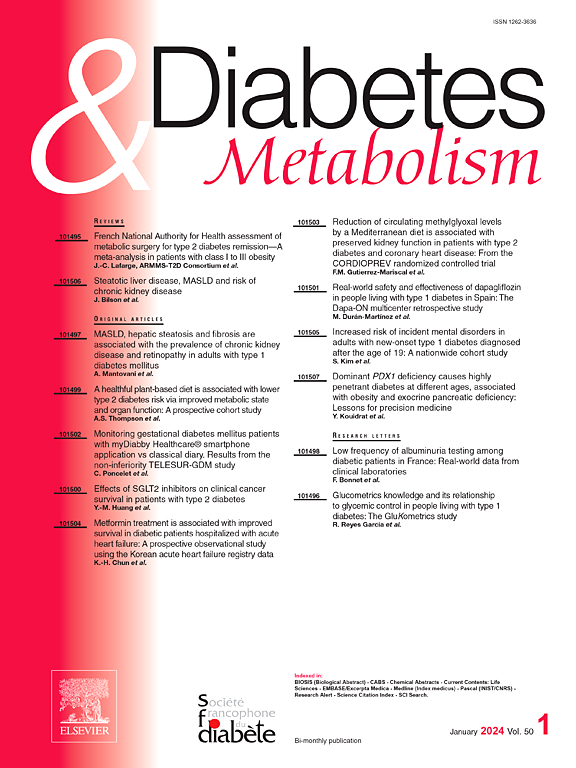皮肤自发荧光高级糖化终产物、血糖记忆和糖尿病并发症。
IF 4.7
2区 医学
Q1 ENDOCRINOLOGY & METABOLISM
引用次数: 0
摘要
自从Meerwaldt和Groningen团队将皮肤自身荧光(SAF)与晚期糖基化终产物(AGEs)的皮肤浓度联系起来的开创性工作以来,数百篇文章致力于其在糖尿病中的应用。由于皮肤胶原蛋白上形成的AGEs周转缓慢,因此SAF可以反映AGEs的进行性积累,因此可以作为长期葡萄糖暴露的标志。因此,在1型和2型糖尿病中,甚至在妊娠期糖尿病中,HbA1c与前3-10年的关系已经建立。然而,存在其他重要的SAF决定因素,特别是年龄、肾功能、饮食和遗传。SAF也与当前和未来糖尿病的微血管和大血管并发症有关,作为血糖记忆的标志。它还与一些重要的新出现的糖尿病并发症和合并症有关,如癌症、认知能力下降和肝脏疾病。前几年葡萄糖暴露的定量信息可能与糖尿病患者的个性化护理有关:当SAF低时优先控制血糖,当SAF高时优先筛查并发症。本文章由计算机程序翻译,如有差异,请以英文原文为准。
Skin autofluorescence of advanced glycation end-products, glycemic memory, and diabetes complications
Since the pionneer work of Meerwaldt and the Groningen team, who related skin autofluorescence (SAF) to the dermal concentrations of advanced glycation end-products (AGEs), hundreds of articles have been devoted to its application in diabetes. Due to the slow turnover of the AGEs formed on collagen of the skin, the SAF can reflect the progressive accumulation of AGEs and hence be a marker of long-term glucose exposure. Accordingly, relations with HbA1c from the previous 3–10 years have been established in both type 1 and type 2 diabetes, and even in gestational diabetes mellitus. Other important determinants of SAF exist however, notably age, renal function, diet, and genetics. SAF is also related to current and future micro- and macrovascular complications of diabetes, as expected for a marker of glycemic memory. It is also related to some important emerging diabetes complications and comorbidities such as cancer, cognitive decline and liver disease. Quantitative information on glucose exposure during the previous years may be pertinent to personnalize care for patients with diabetes: priority for glucose control when SAF is low, and for screening for complications once SAF is high.
求助全文
通过发布文献求助,成功后即可免费获取论文全文。
去求助
来源期刊

Diabetes & metabolism
医学-内分泌学与代谢
CiteScore
12.00
自引率
4.20%
发文量
86
审稿时长
13 days
期刊介绍:
A high quality scientific journal with an international readership
Official publication of the SFD, Diabetes & Metabolism, publishes high-quality papers by leading teams, forming a close link between hospital and research units. Diabetes & Metabolism is published in English language and is indexed in all major databases with its impact factor constantly progressing.
Diabetes & Metabolism contains original articles, short reports and comprehensive reviews.
 求助内容:
求助内容: 应助结果提醒方式:
应助结果提醒方式:


